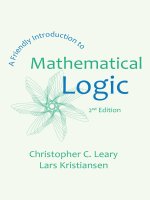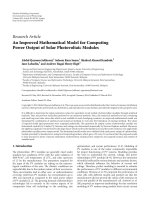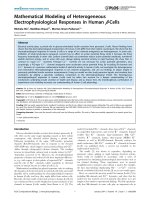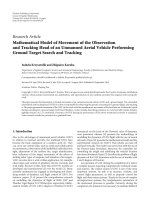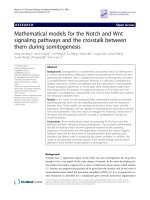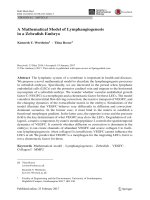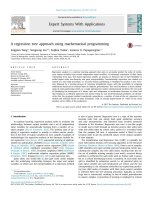Ch02 mathematical preliminaries
Bạn đang xem bản rút gọn của tài liệu. Xem và tải ngay bản đầy đủ của tài liệu tại đây (634.38 KB, 53 trang )
2
2.1
Mathematical preliminaries
Introduction
The purpose of this chapter is twofold: (1) to introduce and discuss a number
of concepts and fundamental results of a mathematical nature which will be
used whenever necessary in the course of our analysis of linear vibrations,
and (2) to provide the reader with some notions which are important for a
more advanced and more mathematically oriented approach to the subject
matter of this text. In this light, some sections of this chapter can be skipped
in a first reading and considered only after having read the chapters that
follow, in particular Chapters 6–9.
It is important to point out that not all the needed results will be considered
in this chapter. More specifically, matrix analysis is considered separately in
Appendix A, while the whole of Chapter 11 is dedicated to the discussion of
some basic concepts of probability and statistics which, in turn, serve the purpose
of introducing the subjects of stochastic processes and random vibrations (Chapter
12). Also, when short mathematical remarks do not significantly interfere with
the main line of reasoning of the subject being considered, brief digressions are
made whenever needed in the course of the text.
So, without claim of completeness and/or extreme mathematical rigour,
this chapter is intended mainly for reference purposes. We simply hope that
it can be profitably used by readers of this and/or other books on the specific
field of engineering vibrations and related technical subjects.
2.2
Fourier series and Fourier transforms
In general terms, Fourier analysis is a mathematical technique that deals
with two problems:
1. the addition of several sinusoidal oscillations to form a resultant
(harmonic synthesis);
2. the reverse problem, i.e. given a resultant, the problem of finding the
sinusoidal oscillations from which it was formed (harmonic analysis).
Copyright © 2003 Taylor & Francis Group LLC
As a trivial opening example, it is evident that adding two harmonic
oscillations of the same frequency
(2.1)
leads to a harmonic oscillation
of the same frequency with a sine
amplitude
and a cosine amplitude
If the two oscillations
have different frequencies, the resultant will not be harmonic. However, if
the frequencies being summed are all multiples of some fundamental frequency
and
ω1, then the resultant oscillation will repeat itself after a time
we say that it is periodic with a period of T seconds. For example, the function
(2.2)
shown in Fig. 2.1, repeats itself with period
seconds, so that
(in Fig. 2.1, note that the time axis extends from
to
If, on the other hand, the frequencies being summed have no common
factor, the resultant waveform is not periodic and never repeats itself. As an
example, the function
(2.3)
is shown in Fig. 2.2 from t=0 to t=50 seconds.
Fig. 2.1 Periodic function.
Copyright © 2003 Taylor & Francis Group LLC
Fig. 2.2 Nonperiodic function.
In short, the process of harmonic synthesis can be expressed
mathematically as
(2.4)
where the quantities An, and Bn are, respectively, the cosine and sine
amplitudes at the frequency ωn. When a fundamental frequency ω1 exists,
then
and we call ωn the nth harmonic frequency.
2.2.1 Periodic functions: Fourier series
As stated before, harmonic analysis is, in essence, the reverse process of
harmonic synthesis. J.B.Fourier’s real achievement, however, consists of the
fact that he showed how to solve the problem by dealing with an infinite
number of frequencies, that is, for example, with an expression of the type
(2.5)
where it is understood that the meaning of eq (2.5) is that the value of x(t)
at any instant can be obtained by finding the partial sum SN of the first N
harmonics and defining x(t) as the limiting value of SN when N tends to
infinity. As an example, it is left to the reader to show that eq (2.5) with the
Copyright © 2003 Taylor & Francis Group LLC
coefficients An=0, and Bn=1/n is the well-known periodic ‘sawtooth’ oscillation
(see Fig. 2.3 representing the partial sum S6 with
).
Incidentally, two short comments can be made at this point.
First, the example of Fig. 2.3 gives us the opportunity to note that a
function which executes very rapid changes must require that high-frequency
components have appreciable amplitudes: more generally it can be shown
that a function with discontinuous jumps (the ‘sawtooth’, for example) will
have A and B coefficients whose general trend is proportional to n–1. By
contrast, any continuous function that has jumps in its first derivative (for
example, the triangular wave of Fig. 1.5) will have coefficients that behave
asymptotically as n–2.
Second, although our notation reflects this particular situation, the term
‘oscillation’ does not necessarily imply that we have to deal with time-varying
physical quantities: for example, time t could be replaced by a space variable,
say z, so that the frequency ω would then be replaced by a ‘spatial frequency’
(the so-called wavenumber, with units of rad/m and usually denoted by k or k),
meaning that x(z) has a value dependent on position. Moreover, in this case, the
quantity 2π/k (with the units of a length) is the wavelength of the oscillation.
So, returning to the main discussion, we can say that a periodic oscillation
x(t) whose fluctuations are not too pathological (in a sense that will be
clarified in the following discussion) can be written as
(2.6a)
Fig. 2.3 Harmonic synthesis of sawtooth oscillation (first six terms).
Copyright © 2003 Taylor & Francis Group LLC
and the Fourier coefficients An, and Bn are given by
(2.6b)
where
is the period of the oscillation and the limits of integration
t1, t2 can be chosen at will provided that
(the most frequent choices
being obviously
or
). Note that the ‘static’
term (1/2)A0 has been included to allow the possibility that x(t) oscillates
about some value different from zero; furthermore, we write this term as (1/
2)A0 only for a matter of convenience. By so doing, in fact, the first of eqs
(2.6b) applies correctly even for this term and reads
(2.6c)
where we recognize the expression on the r.h.s. as the average value of our
periodic oscillation.
As noted in Chapter 1, it often happens that complex notation can provide
a very useful tool for dealing with harmonically varying quantities. In this
light, it is not difficult to see that, by virtue of Euler’s equations (1.7), the
term
can also be written as
(2.7a)
where the complex amplitudes C + and C – are given by
(2.7b)
and no convention of taking the real or imaginary part of eq (2.7a) is
implied because C+ and C– combine to give a real resultant. Then, eq (2.6a)
can also be written as
(2.8)
Copyright © 2003 Taylor & Francis Group LLC
where in the last expression the complex coefficients Cn are such that
(2.9)
and eqs (2.6b) translate into the single formula
(2.10)
Now, if we become a bit more involved with mathematical details we can
turn our attention to some issues of interest. The first issue is how we obtain
eqs (2.6b) (or eq. (2.10)). Assuming that our periodic function x(t) can be
written in the form
let us multiply both sides of this equation by
period, to get
and integrate over one
(2.11)
Noting that
where δmn is the Kronecker delta defined by
(2.12)
then
which is precisely eq (2.10).
Copyright © 2003 Taylor & Francis Group LLC
The second issue we consider has to do with the conditions under which
the series (2.6a) (or (2.8)) converges to the function x(t). As a matter of fact,
three basic assumptions have been tacitly made in the foregoing discussion:
(1) the expansion (2.6a) is possible, (2) the function
under the
integral in eq (2.11) is integrable over one period and (3) the order of integration
and summation can be reversed (r.h.s. of eq (2.11)) when calculating the Fourier
coefficients (eqs (2.6b) or (2.10)). Various sets of conditions have been
discovered which ensure that these assumptions are justified, and the Dirichlet
theorem that follows expresses one of these possibilities:
Dirichlet theorem. If the periodic function x(t) is single valued, has a finite
number of maxima and minima and a finite number of discontinuities, and
if
is finite, then the Fourier series (2.6a) converges to x(t) at all
the points where x(t) is continuous. At jumps (discontinuities) the Fourier
series converges to the midpoint of the jump. Moreover, if x(t) is complex (a
case of little interest for our purposes), the conditions apply to its real and
imaginary parts separately.
Two things are worthy of note at this point. First, the usefulness of this
theorem lies mainly in the fact that we do not need to test the convergence
of the Fourier series. We just need to check the function to be expanded, and
if the Dirichlet conditions are satisfied, then the series (when we get it) will
converge to the function x(t) as stated. Second, the Dirichlet conditions are
sufficient for a periodic function to have a Fourier series representation, but
not necessary. In other words, a given function may fail to satisfy the Dirichlet
conditions but it may still be expandable in a Fourier series.
The third and last issue we consider is the relation between the mean
squared value of x(t), i.e.
(2.13)
and the coefficients of its Fourier series. The result we will obtain is called
Parseval’s theorem and is very important in many practical applications where
energy and/or power are involved. If, for example, we use the expansion in
exponential terms (eq (2.8)) it is not difficult to see that
(2.14a)
Copyright © 2003 Taylor & Francis Group LLC
which shows that each Fourier component of x(t), independently of the other
Fourier components, makes its own separate contribution to the mean squared
value. In other words, no cross (or ‘interference’) terms of the form
appear in the expression of the mean squared value of x(t). If,
on the other hand, we use the series expansion in sine and cosine terms, it is
immediate to determine that Parseval’s theorem reads
(2.14b)
2.2.2 Nonperiodic functions: Fourier transforms
Nonperiodic functions cannot be represented in terms of a fundamental
component plus a sequence of harmonics, and the series of harmonic terms
must be generalized to an integral over all values of frequency. This can be
done by means of the Fourier transform, which, together with the Laplace
transform, is probably the most widely adopted integral transform in many
branches of physics and engineering.
Now, given a sufficiently well-behaved nonperiodic function f(t) (i.e. the
counterpart of the function x(t) of Section 2.2.1) the generalization of the
Fourier series to a continuous range of frequencies can be written as
(2.15)
provided that the integral exists. Then, the counterpart of eq (2.10) becomes
(2.16)
where the function F(ω) is called the Fourier transform of f(t) and, conversely,
f(t) is called the inverse Fourier transform of F(ω). Also, the two functions
f(t) and F(ω) are called a Fourier transform pair and it can be said that eq
(2.15) addresses the problem of Fourier synthesis, while eq (2.16) addresses
the problem of Fourier analysis.
A set of conditions for the validity of eqs.(2.15) and (2.16) are given by
the Fourier Integral theorem, which can be stated as follows:
Fourier integral theorem. If a function f(t) satisfies the Dirichlet conditions
then eqs (2.15) and (2.16)
on every finite interval and if
are correct. In other words, if we calculate F(ω) as shown in eq (2.16) and
Copyright © 2003 Taylor & Francis Group LLC
substitute the result in eq (2.15) this integral gives the value of f(t) where f(t)
is continuous, while at jumps, say at t=t0, it gives the value of the midpoint
of the jump, i.e. the value
Without giving a rigorous mathematical proof (which can be found in
many excellent mathematics texts), let us try to justify the formulas above.
Starting from the Fourier series of the preceding section, it may seem
reasonable to represent a nonperiodic function f(t) by letting the interval of
periodicity
So, let us rewrite eq (2.8) as
(2.17)
where
and we know that the fundamental frequency ω1 is related
to the period T by
In this light, if we define
it
is seen immediately that
so that eq (2.10) becomes
(2.18)
and can be substituted in eq (2.17) to give
(2.19a)
where we define (note that α is a dummy variable of integration)
(2.19b)
Now, if we let
then
Copyright © 2003 Taylor & Francis Group LLC
and, in the limit
so that eq (2.19a) becomes
(2.20)
where we have defined
(2.21)
Equations (2.20) and (2.21) are the same as (2.15) and (2.16). Equation
(2.20) also justifies the different notations frequently encountered in various
texts where, for example, the multiplying factor 1/(2π) is attached to the
inverse transform. The difference is irrelevant from a mathematical point of
view, but care must be exercised in practical situations when using tables of
Fourier transform pairs. Some commonly encountered forms (other than
our definition given in eqs (2.15) and (2.16)) are as follows:
(2.22a)
(2.22b)
(2.22c)
where in eqs (2.22c) the ordinary frequency v (in Hz) is used rather than the
angular frequency
(in rad/s).
Copyright © 2003 Taylor & Francis Group LLC
Example 2.1 Given a rectangular pulse in the form
(2.23)
(a so-called ‘boxcar’ function) we want to investigate its frequency content.
From eq (2.16) we have
(2.24a)
and the graph of F(ω) is sketched in Fig. 2.4.
Furthermore, if we want the Fourier transform in terms of ordinary
frequency, from the condition
and the fact that
we get
(2.24b)
Note that in this particular example F(ω) is a real function (and this is
because the real function f(t) is even). In general, this is not so, as the reader
can verify, for instance, by transforming the simple exponential function
Fig. 2.4 Fourier transform of even ‘boxcar’ function.
Copyright © 2003 Taylor & Francis Group LLC
which we assume to be zero for t<0. The result is
Alternatively, the reader can consider the Fourier transform of the pulse
function f(t)=1/2 for 0
with exactly the same magnitude as the expression (2.24a) but different phase
(because the phase depends on the arbitrary definition of time zero).
Before considering some properties of Fourier transforms, a word on notation
is necessary: in what follows—and whenever convenient in the course of
future chapters—the symbol
will indicate that F(ω) is the
Fourier transform of f(t). Conversely, the symbol
will indicate
that f(t) is the inverse Fourier transform of F(ω). With this notation, the first
easily verified property is linearity, that is
(2.25)
where a and b are two constants and f(t) and g(t) are two Fouriertransformable functions.
A second important property has to do with the Fourier transform of the
function df(t)/dt. Integrating by parts and taking into account the fact that—for
as
we get
the transform to exist—necessarily we must have
(2.26a)
which is just a special case of the relation
(2.26b)
Clearly, eq (2.26b) is true only if
is a Fourier-transformable function
in its own right. By similar arguments, if f(t) is absolutely integrable then the
Copyright © 2003 Taylor & Francis Group LLC
function
then
is continuous. If it is also absolutely integrable,
(2.27)
Consider now two Fourier-transformable functions f(t) and g(t) with Fourier
transforms F(ω) and G(ω), respectively. The function w(t) defined by
(2.28)
is called the convolution of f(t) and g(t) and it has considerable importance
when calculating the time response of linear systems. Provided that
we can take the transform of w(t) and use Fubini’s
theorem (see any book on calculus) to get
Then, by making the change of variable
it follows that
in the t integral,
(2.29a)
which expresses the convolution theorem: in words, the transform of the
convolution f(t) * g(t) is 2π times the product of the transforms of f(t) and
g(t). Again, the position of the 2π factor depends on the definition of Fourier
transform that we use (eqs (2.22a–c)). By the same token, it is left to the
reader to show that
(2.29b)
Copyright © 2003 Taylor & Francis Group LLC
The Parseval formula for Fourier transforms reads
(2.30)
and can be derived as follows. Consider the integral
Assuming that the order of integration is immaterial (again Fubini’s theorem),
we can write it as
(2.31)
or, noting that
and hence
as
(2.32)
so that eqs (2.31) and (2.32) together lead exactly to the Parseval theorem
expressed by eq (2.30). Like its counterpart for periodic functions (eqs (2.14a)
or (2.14b)), eq (2.30) is very important in practical applications when dealing
with the squares of physical time-varying signals, i.e. quantities that have to
do with the energy and/or the power associated with the signal itself.
2.2.3
The bandwidth theorem (uncertainty principle)
The idea of the uncertainty principle comes from the development of quantum
mechanics during the 1920s. The principle, in its most famous form given
by the physicist W. Heisenberg, reads
and, broadly speaking, means
that the product of the uncertainties in position (∆x) and momentum (∆p)
for a particle is always greater than Planck’s constant
More generally, the principle states that any phenomenon described by a
pair of conjugate (or complementary) variables must obey some form of
uncertainty relation.
Copyright © 2003 Taylor & Francis Group LLC
For our purposes the conjugate variables are time t and frequency v and
the uncertainty principle in the field of signal analysis relates the duration of
a transient function (a pulse) to the range of frequencies that are present in
its transform. So, if we call ∆t the duration of the transient f(t) and ∆v the
range of frequencies spanned by F(v), then
(2.33)
which is the so-called bandwidth theorem. The approximation sign in eq
(2.33) means that the product lies usually in the range 0.5–3 for most simple
transients (try, for instance, the boxcar function of Example 2.1, where ∆v
can be approximately taken as the width at the basis of the peak centred at
v=0), but its precise value is not really important for the essence of the
argument. Stated simply, eq (2.33) shows that the two members of a Fourier
transform pair—each one in its appropriate domain—cannot both be of short
duration. The implications of this fact pervade the whole subject of signal
analysis and have important consequences in both theory and practice.
In the course of this text, we will encounter many situations that agree
with eq (2.33): for example, a lightly damped structure in free vibration will
oscillate for a long time (large ∆t) at its natural frequency ωn, so that the
spectrum of the recorded signal will show a very narrow peak at
(small ∆ω); by contrast, if we want to excite many modes of a structure in
a broad band of frequencies (large ∆ω), we can do so by a sudden blow of
very short duration (small ∆t) or by means of a random, highly erratic time
signal, and so on. So, the essence of this short section is that the uncertainty
principle represents an inescapable law of nature (or, at least, of the way in
which we perceive the phenomena of nature) with which we must come to
terms either by looking for trade-offs or by using different methods to extract
all the desired information from a given signal.
Finally, if we observe that for slowly decaying signals it may not be so
easy to define the quantities ∆t and ∆v, we can give the following definitions
in order to make these concepts more precise:
(2.34)
Copyright © 2003 Taylor & Francis Group LLC
These integrals may not be easy to calculate, but they give a prescription
applicable to a wide variety of signals: with these definitions it can be shown
that the bandwidth theorem becomes
2.3
Laplace transforms
From a general mathematical viewpoint, the Fourier transform is just a special
case of a class of linear integral transforms which can be formally written as
(2.35)
where the function K(t, u) is called the kernel of the transform and T{f(t)} is
the integral transform of f(t) with respect to the kernel K(t,u). The various
transforms are characterized by their kernels and their limits a and b so that,
for example, for the Fourier transform
and
Other types of integral transforms are, to name just a few, the Laplace
transform, the Hankel transform and the Mellin transform.
Mathematically, their utility lies in the fact that, with certain kernels,
ordinary differential equations yield algebraic expressions in the transformed
variable (partial differential equations also lead to more tractable problems)
and the solution in the transformed space is found more easily. Clearly, the
problem of finding the solution in the original variable remains and the
calculation of the inverse transformation is often the most difficult part of
the whole procedure.
In its own right—together with the Fourier transform—the Laplace
transform is the most popular integral transform. It is defined as
(2.36)
where s is a complex quantity. Equation (2.36) is particularly useful when
we are interested in functions whose Fourier transform does not exist, i.e.
for example the function
where b>0. In many cases the trouble at
can be fixed by multiplication with a factor e–ct if c is real and larger
than some minimum value a (which, in turn, depends on the function to be
transformed: for f(t)=ebt, for example, we must have c>b), while the ‘bad’
behaviour at
can be taken care of by noting that our interest often
lies in functions f(t) that are zero for t<0. In these circumstances, the function
does have a Fourier transform and we get
Copyright © 2003 Taylor & Francis Group LLC
Introducing the complex variable
we obtain exactly the integral
of eq (2.36) which, in turn, exists only in the right half of the s-plane where
(a is the minimum value for c mentioned above).
Therefore, broadly speaking, we can say that the Laplace kernel is a
damped version of the Fourier kernel or, more properly, that the Fourier
kernel is an undamped version of the Laplace kernel. The inverse transform,
in turn, can be written as
(2.37)
Now, since
and hence
eq (2.37) becomes
from which it follows that
(2.38)
where the integral on the r.h.s. is known as Laplace inversion (or Bromwich)
integral and is understood in the principal-value sense. It converges to f(t)
where f(t) is continuous, while at jumps it converges to the midpoint of the
jump; in particular, for t=0 the integral converges to (1/2)f (0+).
Note that we have made the factor 1/(2π) appear in the inverse transform
and not in the forward transform; this is merely a matter of convenience
due to the fact that the Laplace transform is almost universally defined as
in eq (2.36).
Although in practical situations one generally refers to tables of Laplace
transform pairs (e.g. Erdélyi [1]), the integral of eq (2.38) can be evaluated
as a complex (contour) integral by resorting to the theorem of residues and
the following understanding:
1. For t>0 the integration is calculated along the straight vertical line
Re(s)=c, where c is large enough so that all the poles of the function
F(s)est lie to the left of this line. The contour is closed, forming a large
semicircle around the complex plane to the left of the line.
2. For t<0, since f(t) must be zero, the contour is closed, forming a semicircle
that extends to the right of the line (no poles in the contour). More
details on complex integration can be found, for example, in Mathews
and Walker [2] or Sidorov et al. [3].
Copyright © 2003 Taylor & Francis Group LLC
Now, if we turn to some properties of Laplace transforms, it is not difficult
to show that, first of all, the Laplace transform is a linear transformation
and that the first derivative of f(t) transforms into
(2.39)
Also, a double integration by parts leads to
(2.40)
or, if we write
then, more generally
(2.41)
where—in eqs (2.39), (2.40) and (2.41)—it must be noted that 0 really means
0+, the limit as zero is approached from the positive side.
If f(t) is piecewise continuous, then the function
is
continuous, I(0)=0 and we get
(2.42)
Furthermore, given two functions f(t) and g(t), the convolution theorem
for Laplace transforms reads
(2.43)
where in the rightmost expression we have defined F(s) and G(s), the Laplace
transforms of f(t) and g(t), respectively.
Example 2.2. With reference to the problem of finding the inverse Laplace
transform of a function it is of interest to note that one often has to deal with
functions which can be written as the ratio of two polynomials in s, i.e.
(2.44a)
Copyright © 2003 Taylor & Francis Group LLC
where Q(s) is of higher degree than P(s). If we suppose that Q(s) is a polynomial
of order n with the n distinct roots
then the polynomial in the
denominator can be written as
and the
function F(s) as
(2.44b)
where the coefficients Aj are obtained from
(2.44c)
Since
(2.45)
the inverse transform of F(s) is
(2.46)
As a simple example, consider the function
where the roots of the denominator are
get
therefore
From eq (2.44c) we
and
As for the case of repeated roots and/or more difficult cases in general,
the reader can find more details on partial-fraction theory in any basic text
on calculus or algebra.
Copyright © 2003 Taylor & Francis Group LLC
In the light of the foregoing discussion, we may observe that the main
advantages of the Laplace transform over the Fourier transform are that:
1. The Laplace integral converges for a large class of functions for which
the Fourier integral is divergent.
2. By virtue of eq (2.41), the Laplace transform provides automatically
for the initial conditions at t=0. This latter characteristic will be
considered (and exploited) in the following examples and in future
chapters.
Example 2.3. For this example we consider the ordinary (homogeneous)
differential equation
(2.47)
where a is a constant and we are given the initial conditions
Taking the Laplace transform on both sides gives
and
so that the solution in the s-domain is easily obtained as
Then, from a table of Laplace transforms, we get
and
and hence
(2.48)
which is precisely the result that we will obtain in eqs (4.8) and (4.9) by
standard methods.
On the other hand, if we consider the nonhomogeneous differential
equation
(2.49)
where, for example, the forcing function is
conditions are still given by
of both sides leads, after a little manipulation, to
Copyright © 2003 Taylor & Francis Group LLC
and the initial
Laplace transformation
because
In order to return to the time domain, we
already know the inverse transform of the last two terms, while for the first
term we can use the convolution theorem and write
(2.50)
so that the time domain solution of eq (2.49) is
(2.51)
(see also eq (5.19) with the appropriate modifications).
Partial differential equations can also be solved with the aid of Laplace
transforms, the effect of Laplace transformation being the reduction of
independent variables by one. Also, Laplace and Fourier transforms can be
used together, as in the following example.
Example 2.4. (Initial-value problem of an infinitely long flexible string). This
problem will be considered in detail in Section 8.2; see this section for the
meaning of the symbols.
The equation of motion for the small oscillations of a vibrating string is
(2.52)
Let the initial conditions of the problem be specified by the two functions
(2.53)
Copyright © 2003 Taylor & Francis Group LLC
If we call Y(x, s) the Laplace transform of y(x, t) with respect to the time
variable and transform eq (2.52), we get
(2.54)
Now, let us take the Fourier transform of eq (2.54) with respect to the
space variable x and define
where the variable k (the wavenumber) is the conjugate variable of x. We have
from which it follows that
(2.55)
Taking the inverse Laplace transform of (2.55) gives
(2.56)
and the final solution can be obtained by inverse Fourier transformation of
eq (2.56). The inverse Fourier transform of the first term on the r.h.s. is
(2.57a)
Copyright © 2003 Taylor & Francis Group LLC
while for the second term we may note that
where α is a dummy variable of integration. Hence
(2.57b)
and putting eqs (2.57a) and (2.57b) back together yields
(2.58)
which is the same result we will obtain in eq (8.7a) by a different method.
Incidentally, note that for a string of finite length L, we can proceed from
eq (2.54) by expanding the functions Y(x, s), u(x) and w(x) in terms of
Fourier series rather than taking their Fourier transforms.
2.4 The Dirac delta function and related topics
In physics and engineering it is often convenient to envisage some finite
effect achieved in an arbitrarily small interval of time or space. For example,
the cases with which we will have to deal in future chapters are impulsive
forces which act for a very short time or localized actions applied at a given
point on a structure.
In this regard, the general attitude consists of using mathematics as a
means for handling relations reasonably and efficiently, rather than as a
free-standing discipline. Under the guide of mathematical reasonableness and,
hopefully, physical insight, we often interchange the order of summations of
infinite series (implemented as appropriate limits when necessary) with
integration or differentiation, without asking whether the interchange is
rigorously warranted from a mathematical viewpoint. The final results are
then checked a posteriori for physical sense and consistency, and only at
that stage, in doubtful cases, can we reassess our mathematics. In their own
right, the ideas of the Dirac delta function, the Heaviside function, etc.—
which have been widely used since the beginning of this century without a
rigorous mathematical justification—reflect very well this ‘practical’ attitude.
Before getting a bit more involved with the mathematical details, let us
consider briefly the standard (practical) approach.
Copyright © 2003 Taylor & Francis Group LLC
Intuitively, the Dirac delta function δ(t) (we write it as a function of time
only for future convenience) is defined to be zero when
and infinite at
in such a way that the area under it is unity. So, if a and b are two
positive numbers, we can write
(2.59a)
and
(2.59b)
which evidently implies
The weakness of the
definition given by eqs (2.59a and b) is evident: strictly speaking, one can
object that, first, δ(t) is not a function and, second, that eqs (2.59a) and (2.59b)
are incompatible (if a function is zero everywhere except at one point, its
integral, no matter what definition of integral is used, is necessarily zero).
Nonetheless, one generally ignores these objections and proceeds by stating
that the definition of eqs (2.59a and b) can be replaced by the following and
equivalent definition: let g(t) be any well-behaved function which we may
call a ‘test function’, then
(2.60)
the rationale behind eq (2.60) being that, by virtue of (2.59a), there is no
contribution to the integral from anywhere where
so that g(t) can
be replaced by the constant g(0) which, in turn, can be moved outside the
integral sign. The equality in (2.60) then follows from eq. (2.59b).
Equation (2.60) is the usual definition commonly found in textbooks,
which is sometimes called the ‘weak definition’ of δ(t) because it leaves
undefined the value of the integral when one of the limits of integration is
precisely zero. As a matter of fact, eq (2.60) and its consequences are
compatible with many different assignments of the integrals
(2.61)
which are only subject to the condition
Therefore, any definition that assigns values to the integrals of eqs (2.61) can
Copyright © 2003 Taylor & Francis Group LLC
be called a ‘strong’ definition of δ(t). In practice, however, provided that no
integration stops at zero (as is often the case), no strong definition is necessary
and we can simply ignore the difference. On the other hand, when one of the
integration limits is zero, we definitely need a strong definition, also in the light
of the fact that there exist equations that are ‘weakly true but strongly false’.
On physical grounds, the delta function may arise, for example, in a situation
in which we consider a sudden impulsive blow applied to a mass m. If this
impulsive force f(t) lasts from t=t0 to t=t1, from Newton’s second law we get
(2.62)
stating that the impulse of f(t) equals the change in momentum of the mass.
Also, note that the precise shape of f(t) is irrelevant, the relevant quantity
being its area between the two instants of time. So, let this area be unity and
let, for simplicity, the initial velocity of the mass be
If
is very
small we can simply ignore the motion of the mass during this time and
assume that its momentum changed abruptly from zero to mυ1. As
gets smaller and smaller, the graph of momentum versus time approaches a
step Heaviside function and—since (see eq (2.62)) the function f(t) is the
slope of this graph—we are practically requiring f(t) to be the derivative of
such a step function, i.e. infinite at t=t0 and zero otherwise. No ordinary
function possesses these properties; however, since we are not so much
interested in f(t) itself but in the effect it produces, it can be convenient to
introduce an entity—identified by the symbol
—that represents this
infinitely high and infinitely narrow ‘unnatural’ force. In this light, δ(t) can
physically represent a sudden blow applied at t0=0.
So, returning to the general discussion, it is not difficult to show that the
following (weakly true) properties of δ(t) hold:
1.
(2.63)
Also
2.
where
From the evenness of δ(t) (i.e.
it follows that
3.
Copyright © 2003 Taylor & Francis Group LLC
(2.64)
or
(2.65)
